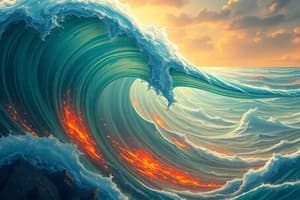Podcast
Questions and Answers
Ozone is composed of two oxygen atoms.
Ozone is composed of two oxygen atoms.
False (B)
The ozone layer, found in the stratosphere, is beneficial to life by blocking ultraviolet (UV) radiation.
The ozone layer, found in the stratosphere, is beneficial to life by blocking ultraviolet (UV) radiation.
True (A)
In the troposphere, ozone is considered a beneficial component of clean air.
In the troposphere, ozone is considered a beneficial component of clean air.
False (B)
Chlorofluorocarbons (CFCs) were found to create ozone molecules in the upper atmosphere.
Chlorofluorocarbons (CFCs) were found to create ozone molecules in the upper atmosphere.
The Montreal Protocol, established in 1987, aimed to increase the global production of CFCs.
The Montreal Protocol, established in 1987, aimed to increase the global production of CFCs.
Specific heat measures the energy needed to raise the temperature of a substance by 2 degrees Celsius.
Specific heat measures the energy needed to raise the temperature of a substance by 2 degrees Celsius.
Latent heat is associated with temperature changes during phase transitions of a substance.
Latent heat is associated with temperature changes during phase transitions of a substance.
Tsunami waves in the open ocean are characterized by their significant height, often reaching tens of meters.
Tsunami waves in the open ocean are characterized by their significant height, often reaching tens of meters.
Gyres, large circular ocean currents, are primarily generated by variations in water density due to temperature and salinity differences.
Gyres, large circular ocean currents, are primarily generated by variations in water density due to temperature and salinity differences.
The South Pacific Subtropical Gyre is recognized as the largest gyre on Earth, influencing weather patterns globally.
The South Pacific Subtropical Gyre is recognized as the largest gyre on Earth, influencing weather patterns globally.
Trade winds, global westerlies, and polar easterlies are classifications of deep ocean currents that drive thermohaline circulation.
Trade winds, global westerlies, and polar easterlies are classifications of deep ocean currents that drive thermohaline circulation.
Upwelling zones are ocean areas near coastlines where winds draw nutrient-poor water from the deep ocean to the surface.
Upwelling zones are ocean areas near coastlines where winds draw nutrient-poor water from the deep ocean to the surface.
El Nino Southern Oscillation is characterized by an accumulation of colder water in the western Pacific Ocean, impacting global weather patterns.
El Nino Southern Oscillation is characterized by an accumulation of colder water in the western Pacific Ocean, impacting global weather patterns.
Thermohaline circulation, also known as the global oceanic conveyor belt, is primarily driven by differences in water color and turbidity.
Thermohaline circulation, also known as the global oceanic conveyor belt, is primarily driven by differences in water color and turbidity.
Air masses moving over cooler ocean water tend to ascend, leading to increased precipitation and cloud formation over land.
Air masses moving over cooler ocean water tend to ascend, leading to increased precipitation and cloud formation over land.
Flashcards
Gyres
Gyres
Large rotating ocean currents created by surface winds.
Great Pacific Garbage Patch
Great Pacific Garbage Patch
A massive buildup of plastic and debris in the North Pacific Subtropical Gyre.
Deep Ocean Currents
Deep Ocean Currents
Deep ocean currents driven by differences in density caused by variations in temperature and salinity (salt content).
Upwellings
Upwellings
Signup and view all the flashcards
El Nino Southern Oscillation (ENSO)
El Nino Southern Oscillation (ENSO)
Signup and view all the flashcards
Thermohaline Circulation (Global Oceanic Conveyor Belt)
Thermohaline Circulation (Global Oceanic Conveyor Belt)
Signup and view all the flashcards
Hadley Cells
Hadley Cells
Signup and view all the flashcards
Tsunamis
Tsunamis
Signup and view all the flashcards
Ozone (O3)
Ozone (O3)
Signup and view all the flashcards
Ozone Layer
Ozone Layer
Signup and view all the flashcards
Ozone Depletion
Ozone Depletion
Signup and view all the flashcards
Temperature
Temperature
Signup and view all the flashcards
Specific Heat
Specific Heat
Signup and view all the flashcards
Conduction
Conduction
Signup and view all the flashcards
Convection
Convection
Signup and view all the flashcards
Study Notes
Tsunamis
- Formed by rapid seafloor displacement (earthquakes, landslides, volcanic eruptions)
- Travel at high speeds away from the source
- Relatively small (1-2 feet) in the open ocean
- Height increases significantly as they approach the shore, causing powerful surges and inland flooding.
- Warning systems exist in the Pacific, and are developing in the Indian Ocean.
Ocean Currents and Gyres
- Ocean water is constantly circulating.
- Gyres are circular patterns created by surface winds
- The North Pacific Subtropical Gyre is the largest, and among impacts:
- Affects weather patterns by drawing cold air down along the West Coast of the U.S.
- Contains the Great Pacific Garbage Patch.
- Two types of currents:
- Surface currents (wind-driven)
- Deep ocean currents (density differences in temperature and salt)
Global Weather Patterns and Upwellings
- Earth has global wind patterns (Hadley Cells) with trade winds, westerlies, and easterlies.
- Upwellings occur where wind blows parallel to the coast, drawing nutrient-rich water from deep depths.
- Highly fertile areas are often near upwellings.
- El Niño Southern Oscillation (ENSO):
- Warmer water buildup in the Western Pacific
- Impacts global weather patterns.
Thermohaline Circulation
- Deep ocean circulation pattern.
- Also known as the global oceanic conveyor belt
- Cycles water throughout all major oceans.
- Driven by differences in density:
- Colder, saltier water sinks
- Warmer, fresher water rises.
Ozone Layer
- Ozone (O3) protects from UV radiation.
- Found in the stratosphere (low concentration, 12 parts per million).
- Found in the troposphere (smog, toxic air pollutant)
- Ozone depletion:
- CFCs (chlorofluorocarbons) can destroy ozone through UV radiation interactions.
- Ozone hole (over Antarctica), discovered in 1985.
- Montreal Protocol (1987): Nations pledged to reduce CFC production (success - 95% reduction).
- Ozone hole is currently recovering, projected return to pre-1980 levels by late 21st century.
Heat and Thermal Expansion
- Heat is energy in the form of particle kinetic energy.
- Measured by temperature (average kinetic energy).
- Specific heat describes energy needed to increase temperature by 1°C.
- Latent heat: Heat transfer during phase changes (no temperature change).
- Thermal expansion: Substances expand as temperature increases (different expansion rates depending on the particle, mass and bonds).
- Laws of thermodynamics govern heat transfer, toward entropy and thermal equilibrium.
- Heat transfer mechanisms: conduction, convection, and radiation.
Studying That Suits You
Use AI to generate personalized quizzes and flashcards to suit your learning preferences.




